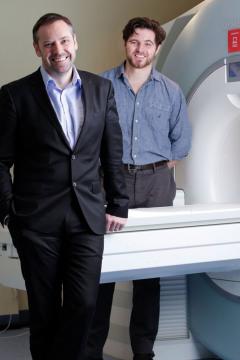Advancing diagnosis of dementia
Dementia researchers are leading a new European initiative that aims to identify and prevent changes that occur in the brain long before symptoms emerge.

2015 saw the University publish the first ‘brain atlas’ – a digital map of the brain designed to assist researchers working in the areas of brain ageing, vascular disease and dementia.
With a suite of powerful MRI and CT scanners available across the University’s medical campuses – and more to be added in the coming year – scientists are capturing detailed images of the body to understand how we can prevent and treat some of the world’s most challenging conditions.
The University’s Dr David Dickie, working with colleagues from Professor Joanna Wardlaw’s research team, based at the University’s Brain Research Imaging Centre, produced the digital map of the brain particularly for their work on the brains of people over the age of 60. This tool is now being used to track how a healthy brain ages, in an effort to aid earlier diagnosis of neurodegenerative diseases, such as dementia.
Maps of the brain
“Brains are very much like faces, in that there is a wide range of what is considered to be normal,” explains Dr Dickie. “By developing maps of the brain, we can quantify that range and track how the brain changes in healthy people over time.”
The team is now recruiting more volunteers in order to build a robust image bank of the brain at all ages. This atlas will be used as the benchmark of healthy ageing, against which the scans of patients with disease could be compared.
As well as diagnosing existing disorders, it may also help to identify the early biological changes that occur before any clinical symptoms of disease develop.
Dr Dickie continues: “Unlike most other parts of the body, it is very difficult to take biopsies of the brain, but advanced imaging is now able to show us much of what’s going on inside and offer information that simply wasn’t available before.
“The challenge is that people who are now aged 70 didn’t have brain scans when they were 10, so we can’t compare directly how their brains have changed over time. We need to build a life-long picture of the brain, and how it changes.”
It is now widely recognised that the key to tackling conditions like dementia lies in earlier diagnosis and preventative treatment. The advances of 21st century medicine allow us to move on from keeping people alive for longer, towards keeping people healthy for longer.
With expertise across the full range of specialisms required for the task – medicine, neuroscience, psychology and informatics – the University has a global reputation for leading the field. The benefits of this have been recognised by the award of a new PET MRI scanner from the Medical Research Council as part of Dementias Platform UK, which is set to arrive at the University in the next year.
There are very real grounds for optimism.
In the case of dementia, the stakes could not be higher. The latest WHO analysis estimates that 47.5 million people currently live with dementia worldwide. That figure is set to triple by 2050.
The annual health and social care costs for the condition, according to a recent study in the British Medical Journal, come to £11.6 billion in the UK – higher than for cancer, stroke and coronary heart disease combined.
Optimism for treatments
Yet despite the fact that the road to finding effective treatments has so far proved long and unrewarding, Professor Craig Ritchie, from the University’s Centre for Dementia Prevention, remains optimistic.
As the lead of a new £50 million initiative aimed at bringing treatments for Alzheimer’s disease to market more quickly – the European Prevention of Alzheimer’s Dementia (EPAD) project – it is easy to understand why.
This new research consortium, which involves more than 36 organisations from across Europe, aims to pinpoint the early stages of Alzheimer’s disease and how it leads to dementia. It will provide a platform to investigate new treatments that aim to prevent or delay the onset of clinical symptoms in people at risk of developing the condition.
Ask Professor Ritchie if he believes a cure will one day be found for dementia, and the answer is resoundingly positive.
“There are very real grounds for optimism,” he says. “We are beginning to understand that the disease process of dementia begins at least 20 or 30 years before symptoms develop, and it is at that point in time that the EPAD project is aiming to intervene.”
The initiative will establish a register of around 24,000 people from across Europe to create a cohort of 6,000 individuals deemed to be at risk of developing dementia. Their level of risk will be determined by cognitive, biological and clinical tests and those in the highest category will be invited to trial new, preventative medicines.
With such a rich data source the team hopes to develop models of the dementia journey, allowing scientists to spot the signposts in those who may be at risk.
So how do you solve a problem like dementia? Professor Ritchie has two proposals.
“There is good emerging evidence that we should explore both pharmacological and lifestyle interventions,” he explains. “Within EPAD, we are hoping to develop treatments that will prevent the biological changes that occur in the brain while the condition is still in its ‘silent’ stage.
“But we must also take very seriously the role lifestyle choices have to play. Diet and exercise are crucial to good brain health and we hope to engage the public with these messages as successfully as the campaigns for tackling cardiovascular disease have done.
“What’s good for your heart is good for your brain, and we believe this type of public health information could prove to be critically important in reducing the risk of dementia in the long term.”

